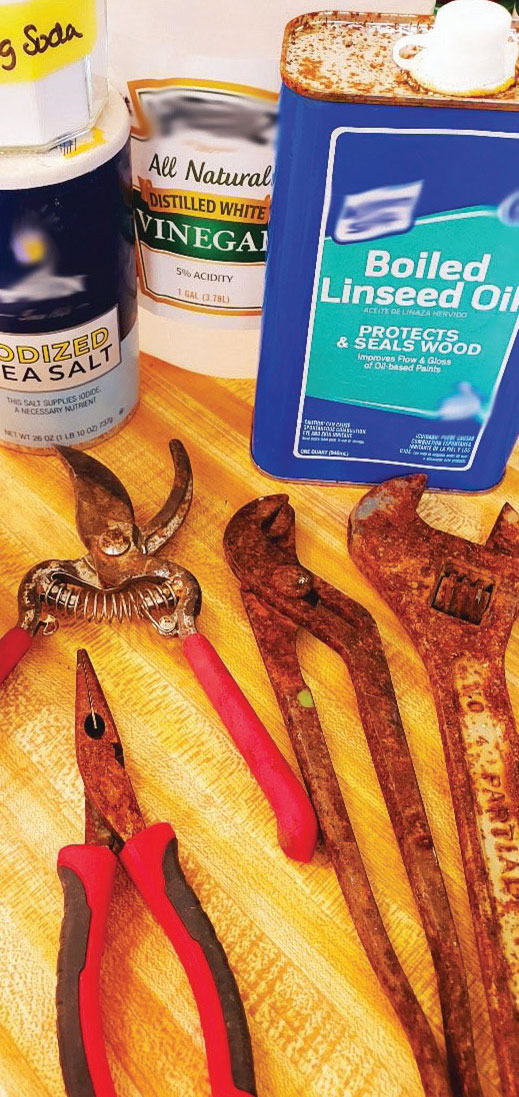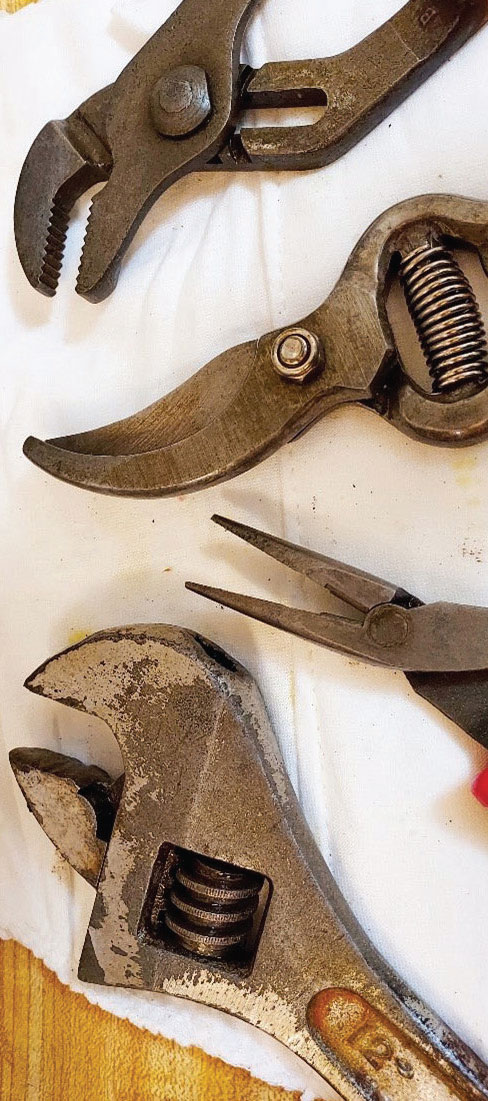DIY: Cleaning Rusty Tools We’ve all done it: forgotten a tool out in the garden, only to find it months (erm, years?) later, fused with dirt and corrosion, crusty, unusable, and sad. This weekend, cleaning out a shed, I found a bonanza of abandoned hand tools, claggy with rust: an adjustable crescent wrench that wouldn’t adjust, a pair of fused pliers, a sad set of pruning shears, and locked-up needle-nosed pliers. Looking at the state of them, it was tempting to give up and send them to the great tool shed in the sky. But… I really didn’t want to. They are (or were) quality tools which should really last a lifetime, and they're expensive to replace! I wanted to salvage them but wasn’t sure where to start. While there are plenty of commercial rust removers available, I wanted something that wasn’t caustic or toxic; I didn’t want to spend a lot of time sanding and scraping the tools, or a lot of money buying cleaning solutions. So, a cup of tea and a web search later, what I found (thank you internet hive-mind) was a “miracle cure” in the form of a simple soak in vinegar and salt. It seemed too easy to be true, but I had all the ingredients on hand, and the tools couldn't get any worse, so I tried it out. And guess what? IT WORKED!
Everyone loves a makeover. Before: sad rusty tools. After: happy clean tools! I mixed distilled white vinegar (5% acidity) and table salt at a 16:1 ratio (1 T salt to 1 cup of vinegar) in a plastic container (use only nonreactive plastic or glass containers for this part). I only made enough to cover my tools up to the neck of the handle because I wasn’t sure it would work and didn’t want to use all my vinegar, but next time I'll make more and use a larger container to cover the handles as well. I placed my rusty tools in the vinegar/salt solution and left them there for 36 hours. Then, using rubber gloves, I removed the tools from the acid bath (the acid is mild, but it won’t be kind to your skin, and liquefied rust can stain your fingers and anything else it touches including countertops, clothes, and sinks so use gloves and caution). The rust was flaking off; I dipped an old toothbrush in baking soda and a good scrub removed most of it. Next, to neutralize the acid so it didn’t continue to interact with the metal and damage it (any more than the rust had already done), I soaked the tools in a 16:1 water/baking soda mixture for 10 minutes. While I was waiting for the tools to soak, I mixed a few tablespoons of baking soda into the used vinegar/salt solution to neutralize the acid, waited for it to stop foaming, then poured it down the drain and rinsed well to remove any residue (nothing in the solution is toxic: vinegar, salt, water, baking soda, and a bit of iron from the rust that flaked off won’t harm the environment, but the rust can discolor surfaces so be careful!) Then, I removed the tools from the neutralizing solution (baking soda is nontoxic, just pour it down the drain), scrubbed any remaining stubborn rust with a bit of steel wool, rinsed the tools in water, dried them thoroughly, and finished with a light coat of lubricating oil to help prevent any more rust from setting in. I used boiled linseed oil because I wanted something non-toxic, but you could use any lubricating oil you’re comfortable with. And just like that! I have a lovely set of clean, usable tools, and maybe I’ll even remember to put them away when I use them… LOL. Okay, maybe not. But at least now I know how to get them back in shape when I leave them out, using a simple, inexpensive, planet-friendly method. And now, so do you! IMPORTANT NOTE: While the 36 hour vinegar/salt soak will not harm steel, it can corrode aluminum. If your rusty tools have any aluminum parts, only leave them in the acid bath for a short time and monitor them closely. This is critical when dealing with threaded aluminum parts, as threads are delicate can get eaten away by acid very quickly. As always, when in doubt, don’t experiment on tools you can’t afford to lose or damage (this goes for surfaces, too)! ♥ top | Newsletter Home |Table of Contents| Archive
|




